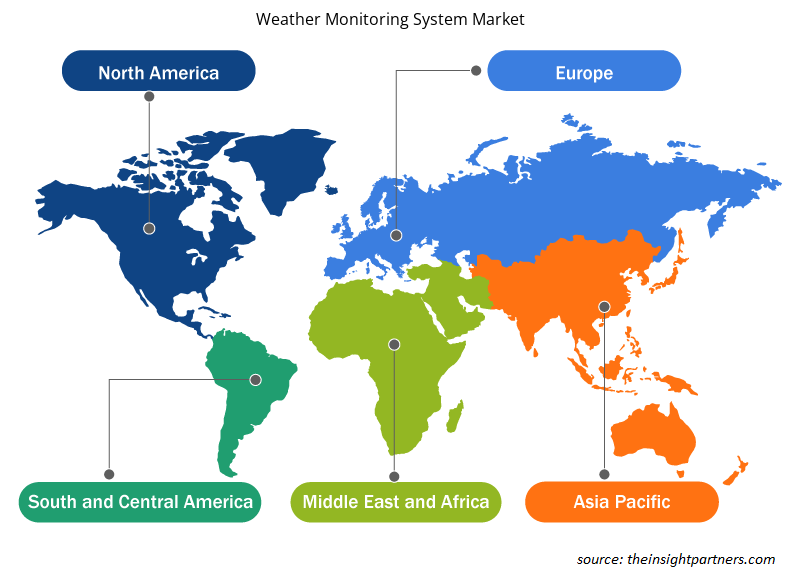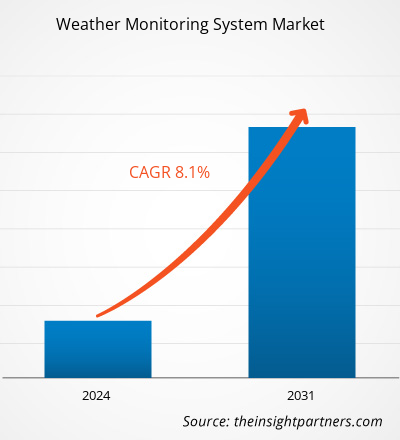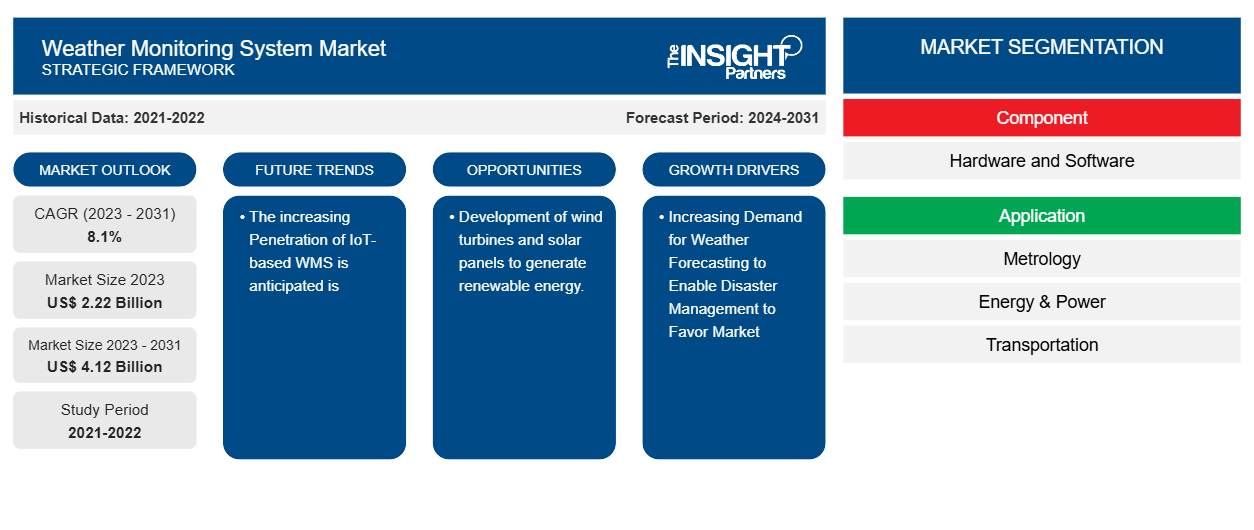天气监测系统 (WMS) 市场规模预计将从 2023 年的 22.2 亿美元增至 2031 年的 41.2 亿美元。预计该市场在 2023-2031 年的复合年增长率将达到 8.1%。天气预报在灾害管理中的应用日益广泛,航空业对天气预报的需求不断增长,这些很可能是天气监测系统市场的主要趋势和驱动因素。
气象监测系统市场分析
全球天气监测系统市场正在经历大幅增长。这种增长归因于气候变化模式导致天气的不确定性以及天气预报在灾害管理中的应用日益广泛。此外,可再生能源产量的增加、超级计算机用于天气预报的计算能力的提高以及基于物联网的 WMS 的普及率不断提高。
气象监测系统市场概况
对气候和大气状况进行持续或定期监测或分析,包括温度、湿度、风速和气压等变量。此外,温度和湿度传感器是最常用的天气传感器。它们可用于计算热指数,了解植物是否面临因温度过高而受损的风险,或确定在特定区域工作是否安全。
定制此报告以满足您的需求
您可以免费定制任何报告,包括本报告的部分内容、国家级分析、Excel 数据包,以及为初创企业和大学提供优惠和折扣
-
获取此报告的关键市场趋势。这个免费样品将包括数据分析,从市场趋势到估计和预测。
天气监测系统市场驱动因素和机遇
天气预报需求增加,灾害管理受市场青睐
为实现灾害管理,对天气预报的需求不断增长,这确实是天气监测系统市场发展的驱动力。天气监测器/气象站是灾害准备和响应的重要工具。通过提供准确及时的天气数据,这些监测器使个人、社区和当局能够规划、减轻风险并有效应对灾难。气象站是气象观测和灾害管理之间的桥梁,促进了更安全、更具弹性的社会。随着技术的不断进步,采用创新方法和整合新功能将加强气象站在未来灾害管理中的作用。因此,考虑到上述参数,越来越多地使用天气预报来实现灾害管理,这是天气监测系统市场增长的驱动力之一。
开发风力涡轮机和太阳能电池板来产生可再生能源。
WMS 是太阳能发电厂的关键组件之一。其功能是收集任何太阳能光伏站点的天气参数数据,例如模块表面温度、太阳辐射、环境温度、风速等,这有助于监测发电厂的效率和性能。进一步分析这些数据与发电厂输出的关系有助于分析和改善发电厂的性能。此外,对于风力发电站的天气数据测量,基于 SmartSolo 数据记录器的气象站安装在永久气象塔上,以测量两个高度的风速和风向,以及温度、相对湿度和气压。因此,由于上述参数,风力涡轮机和太阳能电池板用于产生可再生能源的发展预计将在未来几年为天气监测系统市场带来诸多机会。
天气监测系统市场报告细分分析
有助于得出天气监测系统市场分析的关键部分是组件和应用。
- 根据组件,天气监测系统市场分为硬件和软件。预计硬件部分将在预测期内占据相当大的市场份额。
- 根据应用,市场分为计量、能源和电力、交通运输、航空和其他。预计计量领域在预测期内将占据相当大的市场份额。
天气监测系统市场份额按地区分析
天气监测系统市场报告的地理范围主要分为五个区域:北美、亚太、欧洲、中东和非洲、南美和中美。
北美主导着天气监测系统市场。北美市场分为美国、加拿大和墨西哥。北美地区各行业的高科技采用趋势推动了天气监测系统市场的增长。数字工具的采用率提高、政府机构的高技术支出以及该地区的气候变化模式等因素导致天气的不确定性,而天气预报在灾害管理中的使用率提高预计将推动北美天气监测系统市场的增长。此外,美国和加拿大等发达经济体高度重视研发,这迫使北美参与者将技术先进的解决方案引入市场。此外,美国拥有大量天气监测系统市场参与者,他们越来越专注于开发创新解决方案。所有这些因素都促进了该地区天气监测系统市场的增长。
天气监测系统市场区域洞察
Insight Partners 的分析师已详尽解释了预测期内影响天气监测系统市场的区域趋势和因素。本节还讨论了北美、欧洲、亚太地区、中东和非洲以及南美和中美洲的天气监测系统市场细分和地理位置。

- 获取天气监测系统市场的区域特定数据
天气监测系统市场报告范围
| 报告属性 | 细节 |
|---|---|
| 2023 年的市场规模 | 22.2亿美元 |
| 2031 年市场规模 | 41.2亿美元 |
| 全球复合年增长率(2023 - 2031) | 8.1% |
| 史料 | 2021-2022 |
| 预测期 | 2024-2031 |
| 涵盖的领域 |
按组件
|
| 覆盖地区和国家 |
北美
|
| 市场领导者和主要公司简介 |
|
天气监测系统市场参与者密度:了解其对业务动态的影响
天气监测系统市场正在快速增长,这得益于终端用户需求的不断增长,而这些需求又源于消费者偏好的不断变化、技术进步以及对产品优势的认识不断提高等因素。随着需求的增加,企业正在扩大其产品范围,进行创新以满足消费者的需求,并利用新兴趋势,从而进一步推动市场增长。
市场参与者密度是指在特定市场或行业内运营的企业或公司的分布情况。它表明在给定市场空间中,相对于其规模或总市场价值,有多少竞争对手(市场参与者)存在。
在天气监测系统市场运营的主要公司有:
- 维萨拉
- 三位一体触摸
- Trafitek 解决方案私人有限公司
- Telegrafia 为
- Boltek 雷电探测系统
- 自由精神绿色实验室私人有限公司
免责声明:上面列出的公司没有按照任何特定顺序排列。

- 获取天气监测系统市场顶级关键参与者概览
天气监测系统市场新闻和最新发展
天气监测系统市场通过收集一手和二手研究后的定性和定量数据进行评估,其中包括重要的公司出版物、协会数据和数据库。以下列出了天气监测系统市场的一些发展情况:
- 4 月 11 日,SpaceX 猎鹰 9 号火箭发射了一颗美国太空军气象监测卫星。(来源:SpaceX 公司网站,2024 年 4 月)
- 印度空间研究组织 (ISRO) 成功发射了 INSAT-3DS,这是一颗气象监测和灾害预警卫星。该卫星由 GSLV-F14 火箭从斯里哈里科塔发射升空。(来源:ISRO,新闻稿,2024 年 2 月)
天气监测系统市场报告范围和交付成果
“天气监测系统市场规模和预测(2021-2031 年)”报告对以下领域进行了详细的市场分析:
- 范围内涵盖的所有主要细分市场的全球、区域和国家层面的天气监测系统市场规模和预测。
- 天气监测系统市场趋势以及驱动因素、限制因素和关键机遇等市场动态。
- 详细的 PEST/波特五力分析和 SWOT 分析。
- 天气监测系统市场分析涵盖主要市场趋势、全球和区域框架、主要参与者、法规和最新的市场发展。
- 行业格局和竞争分析涵盖市场集中度、热图分析、知名参与者以及气象监测系统市场的最新发展。
- 详细的公司简介。
- 历史分析(2 年)、基准年、预测(7 年)及复合年增长率
- PEST和SWOT分析
- 市场规模、价值/数量 - 全球、区域、国家
- 行业和竞争格局
- Excel 数据集
近期报告
客户评价
购买理由
- 明智的决策
- 了解市场动态
- 竞争分析
- 客户洞察
- 市场预测
- 风险规避
- 战略规划
- 投资论证
- 识别新兴市场
- 优化营销策略
- 提升运营效率
- 顺应监管趋势























 获取免费样品 - 天气监测系统市场
获取免费样品 - 天气监测系统市场